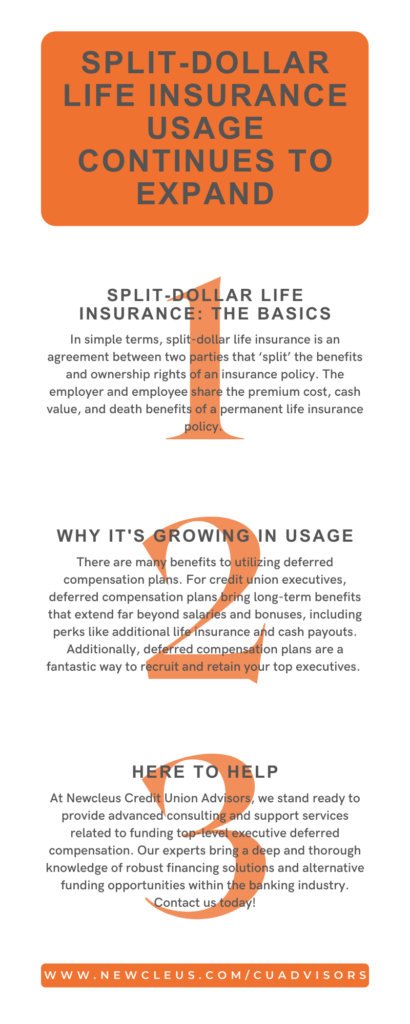


There are many benefits to utilizing deferred compensation plans. For credit union executives, deferred compensation plans bring long-term benefits that extend far beyond salaries and bonuses, including perks like additional life insurance and cash payouts. As we know, deferred compensation plans are a fantastic way to recruit and retain your top executives. Some of the main benefits to split-dollar, including the limited tax burden, have brought this compensation plan front and center for an increasing number of credit unions.
Split-Dollar Life Insurance: The Basics
In simple terms, split-dollar life insurance is an agreement between two parties that ‘split’ the benefits and ownership rights of an insurance policy. The employer and employee share the premium cost, cash value, and death benefits of a permanent life insurance policy.
These plans are typically useful when it comes to estate liquidity—minimizing income, estate, and gift taxes. Tax-exempt corporations might also use these plans to retain top executives.
The two parties establish an agreement in which they determine how long the plan will remain in effect, what each party is expected to accomplish, and when or how the plan will be terminated. Additionally, the agreement establishes conditions that either restrict or end benefits if the employee doesn’t meet their established employee standards or terminates their employment with the company.
There are two types of split-dollar insurance plans: “loan regime split-dollar” (also referred to as “collateral assignment split-dollar”) and “equity regime split-dollar” (also referred to as “endorsement split-dollar” or “economic benefit split-dollar.”)
Read more on the specifics of split-dollar here.

Why Split-Dollar Life Insurance is Growing in Usage
Split-dollar life insurance usage continues to grow. The use of split-dollar life insurance is especially expanding among non-CEO executives. But why?
To begin, split-dollar life insurance has started to gain traction relatively recently, while split-dollar has been used in various forms in credit unions since the 1980s, the Loan Regime (or Collateral Assignment) form of the plan began to be used in credit unions beginning around 2001. Following the financial crisis, as credit unions became more GAAP-earnings sensitive, this version really began to gain steam.
A 457(b) plan is a defined contribution plan with contribution limits. In essence, a 457(b) plan augments a 401(k) plan to generate greater retirement income. Typically, these plans are the first steps in supporting an executive benefits package.
A 457(f) plan, on the other hand, has the ability to be a defined contribution plan or a defined benefit plan. The plan has no inherent contribution limits—offering flexibility for an executive.
Although the CUES Executive Compensation Survey shows that 457(b) and 457(f) plans continue to be the most commonly used deferred compensation tools by executives, the survey results also indicate a clear uptick in the use of split-dollar beginning in 2017.
The CUES survey showed that 457 plan usage held steady—not increasing—for CEOs of credit unions. Specifically, 457(b) plan usage stood at 45.3% and at 38.5% for 457(f) in the updated 2020 survey.
Split-dollar life insurance, on the other hand, was being offered to CEOs 37% more in 2020 than it was in 2017. Bringing the usage of split-dollar life insurance nose to nose with 457 plans.
According to a study, executives who received split-dollar plans included:
- 23.1% of Chief Operating Officers (A 402% increase!)
- 33.6% of Second Executive Officers
- 10.1% of Chief Lending Officers
- 14.9% of Chief Financial Officers
- 35.3% of Chief Executive Officers
Here to Help
The important aspect of implementing any deferred compensation plans—including split-dollar life insurance—is ensuring the design you choose to implement matches the objective you’re trying to accomplish. Be sure you’ve carefully considered the benefits and drawbacks of the chosen plan design in the language a board or management team can understand.
At Newcleus Credit Union Advisors, we stand ready to provide advanced consulting and support services related to funding top-level executive deferred compensation. Our experts bring a deep and thorough knowledge of robust financing solutions and alternative funding opportunities within the credit union industry. Contact us today!
